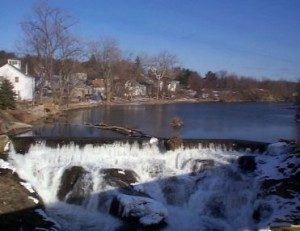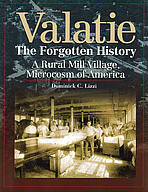 Like many communities in New York’s Hudson River valley, Valatie was settled in the early seventeenth century by Dutch colonists. It’s pronounced “va LAY sha”, by the way, not “VAL-a-TIE”. The name comes from the Dutch “vaaltje” for “little falls”, after the small but scenic waterfall that commands the center of the village.
Like many communities in New York’s Hudson River valley, Valatie was settled in the early seventeenth century by Dutch colonists. It’s pronounced “va LAY sha”, by the way, not “VAL-a-TIE”. The name comes from the Dutch “vaaltje” for “little falls”, after the small but scenic waterfall that commands the center of the village.
The original inhabitants of the area were, of course, Native Americans. The “Meeting Place” (“Pachaquack”) south of the “Great Fish Lake” (“Wogashawachook”), now Kinderhook Lake, may well have referred to the confluence of the Valatie Kill and the Kinderhook Creeks. And just east of the current village was Pompoonick, a Mohican settlement probably named after a local chief, Pompoen.
Records of the European settlement date back to about 1665. From the beginning, the abundance of water power provided by the two creeks supported the establishment of numerous mills in the area. As early as 1697, grist and saw mills had been erected on the banks of the streams. In 1817 Manchester, England, native Nathan Wild settled in Valatie. With two associates, he formed the Kinderhook Manufacturing Company, and began the spinning of cotton yarn and weaving cotton shirting by hand-looms. In 1828, the partners built a brick factory for sixty looms (a large mill at that time). In 1845 Wild visited England, and soon after his return he erected a factory for ten thousand spindles and two hundred looms.
Meanwhile four other textile factories located on or near the Kinderhook Creek (including one adjacent to the waterfall shown above) propelled the village into a position of being one of the leading manufacturing centers in New York State. So successful did these factories become, that by 1829 a proposal was put forward to change the name of the village to Millville. This rather unimaginative proposition held sway for a few years, but when its first post office was established in 1832, the original name was restored. It was further formalized when the village incorporated, in 1856.
For more information about the village today, visit the official website of the Village of Valatie at http://www.valatievillage.com/.
Martin H. Glynn
Unlike neighboring Kinderhook, Valatie can’t claim a president among its native sons. It can, however, take pride in the accomplishments of Martin H. Glynn, who rose to the highest levels of New York State government, and who played an important role in modern European history as well. Click here for more information on Martin Glynn.
Valatie’s “Forgotten History”
 An excellent source of information about Valatie’s past is local historian and author Dominick Lizzi’s Valatie: The Forgotten History, now available at the library. The book includes numerous maps and photos, many never before published. It chronicles the life and times of a small New York village – from the earliest native settlements to the dawn of the 21st century. Mr. Lizzi is also the author of Forgotten Hero, a biography of Governor Martin H. Glynn.
An excellent source of information about Valatie’s past is local historian and author Dominick Lizzi’s Valatie: The Forgotten History, now available at the library. The book includes numerous maps and photos, many never before published. It chronicles the life and times of a small New York village – from the earliest native settlements to the dawn of the 21st century. Mr. Lizzi is also the author of Forgotten Hero, a biography of Governor Martin H. Glynn.